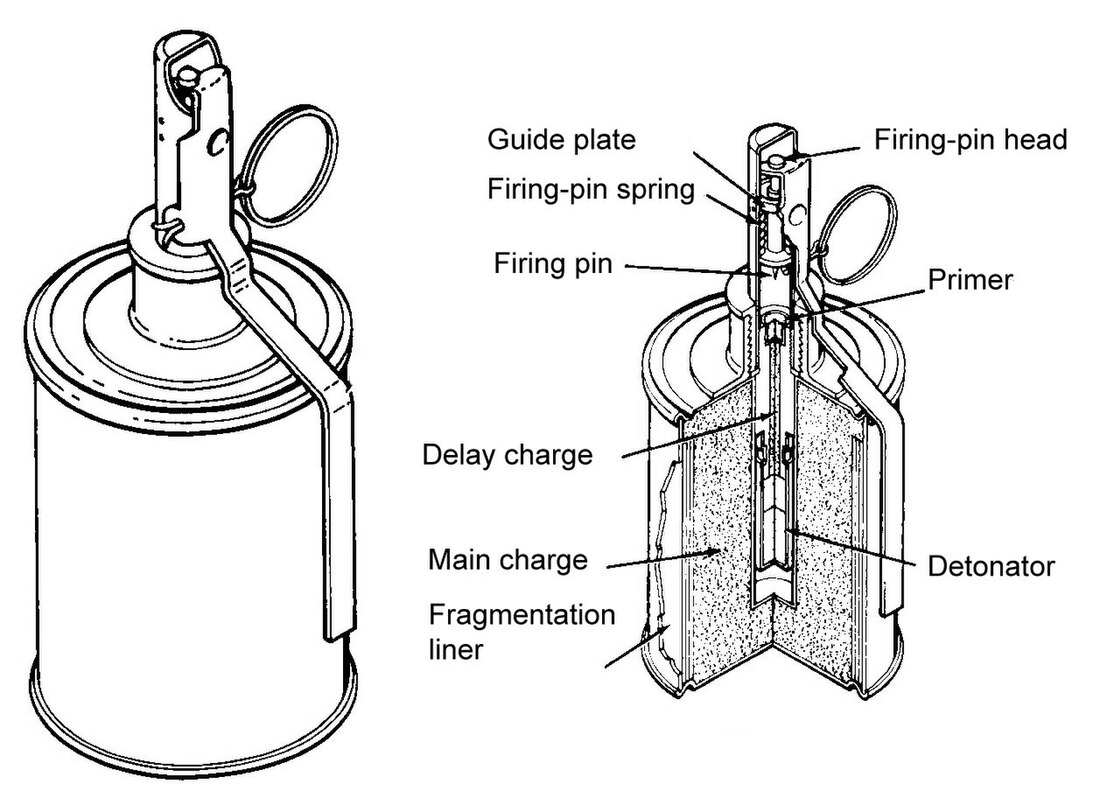Top Qs
Timeline
Chat
Perspective
RG-42
Soviet hand grenade From Wikipedia, the free encyclopedia
Remove ads
The Soviet RG-42 (Ручная Граната образца 42 года > Ruchnaya Granata obraztsa 42 goda, "Hand Grenade pattern of [19]42 year") was a fragmentation grenade designed by S. G. Korshunov.
While it was introduced as a stopgap measure to replace the complex and expensive RGD-33 grenade, it remained in use with the Soviet Union, Warsaw Pact countries, and allied nations such as People's Republic of China after World War II. In Soviet service it was used until 1981 during the Soviet-Afghan war.
Remove ads
Design
Unlike the RGD-33, the RG-42 was a simple design, being a little more than a steel sheet cylinder filled with explosives.[3] It required no casting and were produced in existing can factories. It also shared the UZRG fuse used on the F-1 grenade.[4]
It contained approximately 110–120 g (3.9–4.2 oz) of the high explosive (TNT) in a cylindrical stamped-metal can.[3] According to Rottman, the fragmentation liner was a thin sheet of steel rolled into three layers with diamond shaped grooves.[4]
The RG-42 was fitted with a UZRG or UZRGM fuze with a 3.2−4.2 second delay, same types used by the F-1 and RGD-5 grenades.[3][5]
The grenade could be thrown about 30–40 m (33–44 yd) and has an effective fragmentation radius of approximately 25 m (27 yd).[6] While the blast effect is dangerous over radius of at least 10 m (11 yd).[3]
The total weight of the grenade with the fuze was 420 g (15 oz).[2]
Remove ads
History
Summarize
Perspective
The RG-42 was originally introduced during World War II from 1942 onwards as an emergency measure to replace the RGD-33 grenade,[1] a pre-war design which proved to be too complex to operate, too expensive and time-consuming to produce.[7] It remained in use with the USSR, Warsaw Pact countries, and Communist China in the post-war period.[4]
After World War II, it saw action with Communist forces in the Korean War alongside the Chinese-made Type 42;[8] and North Vietnamese troops during the Vietnam War.[9]
The RG-42 was still used by Soviet troops alongside the F-1 and RGD-5 as late as 1981,[5] during the early stages of the Soviet-Afghan war.[10] In the mountains of Afghanistan, the 3.2−4.2 second delay fuze not only gave the mujahideen enough time to search for cover, but it also posed the danger of the grenade rolling back to friendly positions after it was thrown.[11] As result the RG-42 was replaced by the RGN and RGO hand grenades,[10] which were introduced mid-1980s.[4]
In the 1990s, it was still used by Iraqi forces during the Gulf War;[12] During the Georgian Civil War several paramilitary groups purchased ex-Soviet surplus grenades from Russian officers;[13] In 1992, prior to the First Chechen War, it was estimated that Chechen forces loyal to separatist leader Dzhokhar Dudayev captured 80,000 RG-42s from ex-Soviet stocks;[14] In 1994, several Afghan militias including the Taliban possessed some grenades alongside other Soviet small arms left behind following the collapse of the Najibullah regime.[15]
Despite the RG-42 age, it was "still likely to be found almost anywhere, especially in Africa and the Balkans" in the 2010s, according to Jane's;[3] In 2011, Azerbaijan security forces seized at least three grenades from Caucasus Emirate insurgents;[16] In 2019, during the war in Donbas, Ukrainian forces seized at least one grenade from the pro-Russian insurgents.[17]
Remove ads
Foreign copies
Although the RG-42 is considered obsolete, China still produced copies (as the Type 42 grenade) until the late 2000s, while Poland and Romania produced the RG-42 as late as 2010.[3]
According to US intelligence, Czechoslovakia and North Korea have also produced and used locally made copies of the RG-42.[18][19]
Users
 Afghanistan − Captured by the Afghan mujahideen[15]
Afghanistan − Captured by the Afghan mujahideen[15] Bulgaria[20]
Bulgaria[20] Caucasus Emirate[21]
Caucasus Emirate[21] Chechen Republic of Ichkeria[22]
Chechen Republic of Ichkeria[22] China − Produced locally as the Type 42[3]
China − Produced locally as the Type 42[3] Czechoslovakia[18]
Czechoslovakia[18] East Germany[23][24]
East Germany[23][24] Georgia − Used during civil conflicts in 1990s[13]
Georgia − Used during civil conflicts in 1990s[13] Iraq[12][25]
Iraq[12][25] North Korea − Were used at least until 1997[19]
North Korea − Were used at least until 1997[19] Poland[26] − Were used at least until 2019[27]
Poland[26] − Were used at least until 2019[27] Romania[3]
Romania[3] Soviet Union[2]
Soviet Union[2] Ukraine − Several were kept in storage as late as 2017.[28][29][30] Seen in use as late as April 2024, according to the Russian MoD[31]
Ukraine − Several were kept in storage as late as 2017.[28][29][30] Seen in use as late as April 2024, according to the Russian MoD[31] Vietnam[9]
Vietnam[9]
Remove ads
Western Sources
- Brassey's Infantry Weapons of the World describes this grenade as having 118 g (4.2 oz) of TNT, 20 metres (22 yd) fragmentation effect, and a 40 metres (44 yd) tossing range.[32]
- According to Jane's the RG-42 have a height of 130 mm (5.1 in) with fuse and 85 mm (3.3 in) without, and a mass without fuse of 384 g (13.5 oz).[3]
References
Bibliography
External links
Wikiwand - on
Seamless Wikipedia browsing. On steroids.
Remove ads

